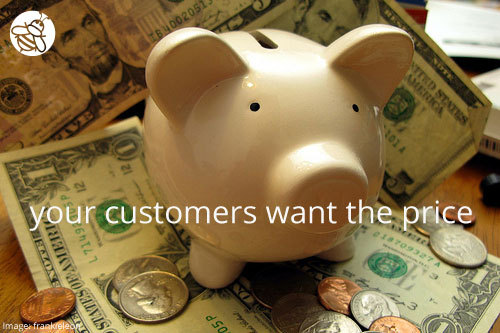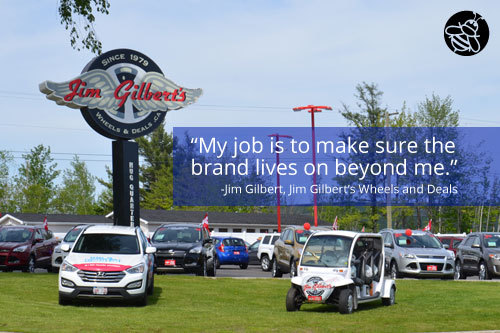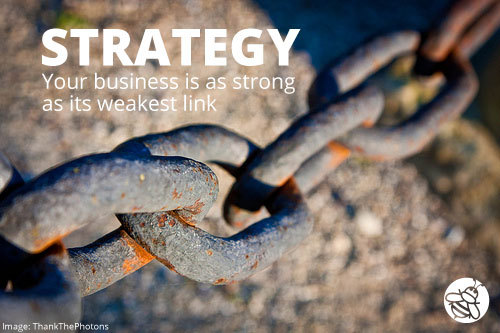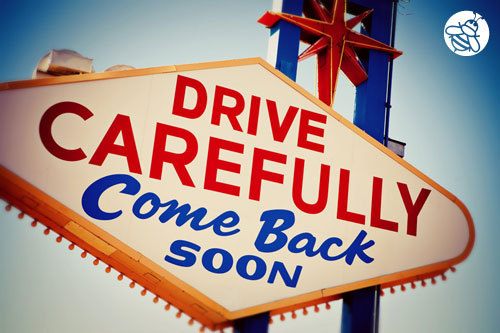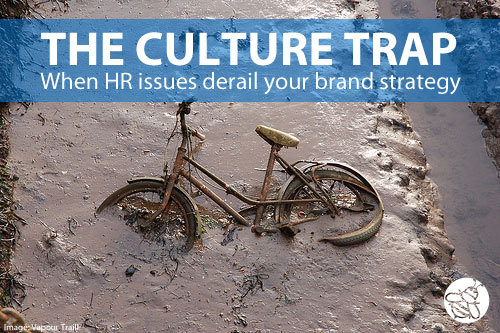Jeremy Miller's Blog, page 36
June 23, 2015
Public Speaking Is Like Snowboarding
It’s one of the best feelings in the world. Your heart is racing, your legs are shaking, and you’ve got a smile from ear-to-ear.
That’s how I feel when I push myself on my snowboard, and I feel the exact same way when I walk off the stage after a keynote presentation.
This may be a seasonally inappropriate simile. As I write this post I am sitting on my patio. It’s 30ºC (86ºF) outside, and there’s a beer beside me. (Yeah, it’s good to be an entrepreneur.) But bare with me for a moment.
Snowboarding is my favorite winter sport, and it has a lot of parallels to public speaking.
Speaking is one of the most thrilling things you can do in business. It’s an adrenaline rush to get up in front of people and share your ideas. And it’s an absolute thrill to connect with your audience and nail your talk.
Speaking is also a very deliberate activity. You’re not born an incredible orator. It takes training, practice, and the ability to pick yourself up when you fall down.
Break Through Plateaus
The idea for this post originated with a conversation I had over the weekend. A friend of mine was asking me about my latest speaking activities, and how my skills have evolved.
This has been a whirlwind year for me. Since Sticky Branding (the book) launched in January I have been speaking almost weekly. But my talk at the Family Business Symposium in May was a breakthrough in my speaking.
It’s hard to explain, but several things came together on that stage. I could feel myself rise to a new level in capabilities and delivery.
As I told my friend, it felt like learning a 360. A 360 is a snowboard trick where you do a complete spin, rotating 360º, in one jump. I fell countless times trying to figure out how to land a 360, but once I landed it I never forgot how to perform the trick.
The same was true at the Family Business Symposium. I have been pushing myself with each talk to connect with my audience and live in the moment. This has been surprisingly challenging. There’s so much happening on stage that I find it hard to get out of my own way. At Symposium I made a few adjustments to my prep and approach, and it made all the difference. I nailed it.
To break through plateaus in your speaking takes practice. You’ve got to speak a lot to be a great speaker.
Get Back Up After a Fall
Speaking can be a high risk activity. Things can and will go wrong, and this can be incredibly embarrassing when it happens.
In the mid-2000s I was the labor pundit for a local television station. I appeared regularly to talk about the job market and the economy. On my third appearance on TV the anchor asked me an unexpected question, “So why are you here Jeremy?” I felt like a deer in the headlights. I didn’t know how to respond and just started rambling.
After what felt like an eternity, the producer signaled for me to wrap it up. This all took place in ninety seconds, but I was mortified. I couldn’t believe how poorly I had performed. The funny part is no one else noticed. Friends and family said I looked a bit nervous, but it really wasn’t that bad.
This was a valuable experience. It was an opportunity to get better.
A key lesson in snowboarding is if you’re not falling you’re not growing. Snowboarders rarely stick a trick on the first attempt. When you crash you get up, brush yourself off, and go do it again.
I hired Mark Bowden for speaker training, and I studied the tapes of my appearance. The way I was approaching TV was flawed, and this was my opportunity to fix it. With Mark’s help I broke through another plateau, and appeared on TV for over five years after that. That crash gave me the opportunity to become a pundit versus a guest.
Be prepared to take risks and push yourself on stage. Not everything works out, but that’s how you learn. And when you fall, get back up and do it again.
Enjoy The Thrill
I like to compare speaking to snowboarding, because it’s the only thing in business that gives me the same adrenaline high.
Speaking is a rush.
When you walk off stage your heart is racing, your legs are shaking, and you’ve got a smile from ear-to-ear. That’s a feeling worth replicating.
June 18, 2015
Should You Publish Pricing On Your Website?
This is a contentious question, and I am once again wrestling with it.
I am in the midst of redesigning the Sticky Branding website, and we’re having a big debate internally, “Do we publish our rate card?”
I don’t have the answer, but I’d like to take you through the thinking behind whether to publish your pricing on your website. My ask to you: what do you think? Should a B2B company publish its rates on its websites?
Share Price? The Hell No Stance
I have been mentored to believe publishing your prices is a big no no.
The reasons against publishing pricing are straightforward:
Sticker Shock: There’s a perceived risk that you can scare customers away. They will see the price without understanding your value proposition, and that may drive them to seek out cheaper solutions.
I can’t resist, but shoot this one down right away. If you’re customers can’t see the value proposition from your front door then you have a branding problem. Life’s too short to build your business selling to price sensitive bottom feeding customers.
Pricing is Variable: In many organizations the fee structure is variable. This is true of most professional services companies. The fee is dependent on the deliverables and amount of work performed. Publishing a rate card may not be straightforward, at least compared to pricing models used by product driven companies.
The counter argument to variable pricing is to share price from a different perspective. In my previous company, LEAPJob, our minimum fee was $9,900. This was based on recruiting sales and marketing professionals that had a salary of $45,000 or greater. We openly published that the “starting salary” for any role we took on had to be at least $45,000. This let customers self-select if their roles were in line with our services.
Don’t Educate the Competition: The other reason to avoid publishing price is you can make it too easy for your competition. They can use that intel against you.
I definitely find this a tricky issue, especially for industries that sell through a bidding process. Publishing your pricing may create an opening for the competition to slightly undercut your prices in a RFP (request for proposal) or tender.
That said, we can also overestimate the competition. As the old saying goes, mimicry is the highest form of flattery. If the competition is copying your services and pricing models then your company is defining the brand category and industry expectations. The strength is in your favor.
Price is a Segue: My number one reason for not publishing price up until now is it’s a great call to action. When someone is ready to discover the price it’s time for a conversation. They are receptive to a sales call, and you can accelerate the sales process by getting the customer on the phone.
Positioned to Negotiate: The other major sticking point for publishing price, and this one really does concern me, is it sets up the customer to negotiate. For example, the customer sees a service is $10,000 but they say, “We love it, but we’ll only pay $8,000.”
Engaging in a price negotiation at the start of a sales cycle is dangerous. It’s not the way I want to start a relationship. I don’t have the experience to know if this situation is real or not, but it does give me cause for concern.
Publish Your Pricing? The Hell Yes Point of View
Even though my background says not to publish price my gut is taking me in a different direction. The internet has changed expectations. We live in an information rich market, and if customers want the price then give it to them.
Price is Everywhere: Price isn’t hard to find anymore.
We first got conditioned to discover the price by the car companies. You can configure any car and their websites will give you the exact price. This practice has extended well beyond the automotive industry now. Most software companies have a section titled “Pricing,” and it’s super easy to find: Salesforce.com, Buffer, Hubspot, InfusionSoft.
And even if the price isn’t published on a company’s website you can usually get it from an existing customer on social media. Ask the question on Twitter or Facebook, and if the company is large enough (or prominent enough) you’ll get an answer.
Published Pricing Saves Time: Let your customers determine if your services are a fit.
One of my biggest priorities is to drive Velocity into the buying cycle. I want to achieve the Two-Call Close — and if I could make it a One-Call Close, even better. A primary way I achieve this is through making my website sell as well as my best sales person. My thinking is any information I would give in a sales call should be on the website.
This helps me in two ways. First, it eliminates people that aren’t a fit. This saves them time, and it saves me time. Second, it positions the services by helping customers understand where the services fit in the spectrum of marketing options available to them. Price is a positioning tool.
The Customer Wants Pricing: This is the number one reason for me to publish price. If the customer wants that information then give it to them. It’s a key aspect of their decision making process. If it helps them make better buying decisions faster, it just makes sense to publish your rates proudly on your website.
Publishing your prices on your website doesn’t fulfill your value proposition or make your brand stickier, but it can whet your customers’ appetite to buy faster.
Your Turn
What’s your opinion? Should a B2B company publish its fees on its website? More specifically, should Sticky Branding publish its rates?
I can easily do it. My pricing is well defined and easy to understand. There are no surprises, and it could easily be published in a simple one-page format.
What do you think?
June 16, 2015
Your Team Forgets Your Brand Every Friday
“My number one job is to retell our brand story every single week,” says Jim Gilbert, CEO of Jim Gilbert’s Wheels and Deals.
Wheels and Deals is one of the largest independent used car dealership in eastern Canada, and it’s obvious why when you visit it. I had the pleasure of speaking at an event they hosted last week, and was blown away to see this company and its brand. (Here’s me sharing the stage with their mascot, Chrome the bulldog. She stole the show.)
Wheels and Deals sweats the little things: from the look and feel of their dealership; to the way their team interacts with customers; to how customers get a hug when they visit the dealership; to the company’s logo emblazoned on everything.
And when I say the logo is on everything — I mean everything. Even the sales reps’ shoes had “Canada’s Huggable Car Dealer” on them. One sales person told, “If you can put a logo on it, Jim will find a way.”
But what delights me most about Wheels and Deals is the depth of their brand. It’s not a superficial marketing effort. The brand is rich, deep, and nuanced. And it is protected by the leadership team.
Jim says, “My job is to make sure the brand lives on beyond me. I repeat and reinforce our story and our beliefs every single week.”
Jim assumes his team forgets everything he taught them at the end of each week. It’s like someone hits the reset button on Friday at 5pm, and the job begins anew on Monday morning. “Every week I have to go back to basics and reinforce the brand. I share our stories and why we do what we do,” says Jim.
Jim may feel like a broken record at times, but he is motivated by a core belief, “If I miss a week it costs me two, and if I miss two weeks it costs me four.” This means it takes twice as long to get your team back on track if you stop reinforcing your brand.
“It’s the simplest things that go first — like the hugs,” says Jim. Those are the basics that create the Wheels and Deals’ customer experience and make it special, but they are also the uncomfortable behaviors that people may avoid. And if Jim and his team let those behaviors slip — even for a week — it takes twice as long to get everyone back on track.
Jim Gilbert’s message really resonates with me:
Reinforce your brand weekly.
The job never ends. Assume your team forgets everything you taught them at the end of each week.
If you miss a week it costs you two. If you miss two weeks it costs you four. Every time you stop reinforcing your brand you will pay for it in multiples.
Are you reinforcing your brand weekly with your team?
June 11, 2015
The Weakest Link in Your Strategy
A strategy isn’t of much value if you can’t execute it.
Leadership teams work hard on strategy development, but it’s often the little things — the unseen things — that derail a strategy from being implemented.
The things that derail a strategy are the weak links in an organization: a flawed compensation system; bureaucracy; the wrong people; misaligned products; weak customer service; or a whole host of other issues. These are the things that keep me up at night. I wrote about the Culture Trap — how HR issues derail a strategy — a few weeks ago.
A key step in the process of developing and implementing a marketing strategy is to understand the weak links in your organization.
Chain Link Systems
Richard Rumelt, author of Good Strategy / Bad Strategy, writes, “A system has a chain-link logic when its performance is limited by its weakest subunit, or ‘link.’ When there is a link, a chain is not made stronger by strengthening the other parts.”
Rumelt illustrates this premise through the story of why the NASA Challenger spaceship exploded on launch in 1986. The weakest link in the space shuttle was an O-ring in the booster engine. When the O-ring failed hot gas burst through the structure and caused the rocket to explode.
This is a dramatic example, but clearly illustrates the chain link analogy. The weakest point in your organization can wreak havoc on your strategy.
Chain Links Create Strength
As much as a weak link can derail a strategy, a strong chain link system can grow your brand.
The system creates strength. When you have all of your departments and functions working in tandem to achieve the strategy you can deliver remarkable results.
Amazon, for example, is the largest online retailer in the world, and arguably the most successful retailer in the world. And it’s the chain link system that makes Amazon such a powerful brand.
Brad Power and Ric Merrifield write in their Harvard Business Review article, “Too Much Profit Can Doom Your Company”, “Amazon keeps margins razor thin, as part of its mission to become the best place to buy just about everything. As CEO Jeff Bezos has said, ‘Your margin is my opportunity.’ Amazon is maniacally cost-focused, but rather than letting benefits flow to profit, they pass them along to their customers.”
Amazon’s system coupled with its focus on being the “best place to buy everything” is their strength.
Balance Strengths and Weaknesses
Viewing your strategy through a chain link analogy is very powerful. It highlights the balance that comes from developing and implementing effective strategies.
The chain is only as strong as its weakest link.
As you develop your strategy look at your organization from three angles:
Strengths
Weak Links
The System
Your organization has a lot of moving parts, and ideally you are bringing all the pieces together to strengthen the system and achieve your strategic objectives.
June 9, 2015
Sticky Branding Workshop – It’s Free!
The ultimate measure of a brand’s performance is sales. Sticky Brands really do sell more faster.
With that in mind, I’d like to invite you to a free workshop on July 22, 2015 in Mississauga.
That’s right. This is a real in the flesh honest to goodness workshop. No cheap webinars. We’re hosting a live event, and it’s free! 
It’s been several years since I’ve run a public workshop. It’s something I get asked to do all the time, but these events take a ton of work to execute effectively. But when Darren Rabie — sales expert, speaker, and president of Focus America — said “Let’s put one on together,” I jumped at the opportunity.
Darren and I are putting on a two hour workshop. We’re each tackling the question, “How do organizations dramatically improve sales performance?”
What You Will Learn
Darren and I are an interesting duo. We are both passionate about improving sales performance, but we tackle the challenge from very different angles.
The workshop is delivered in two parts. I will be speaking about sales performance from the branding angle, and Darren will be talking about it from the sales force’s perspective.
Jeremy Miller: The Two Call Close
I will show you how to leverage your brand to win big contracts fast. My talk is titled, “The Two Call Close.”
The Two Call Close is the holy grail of branding, and the epitome of selling. It’s the ability to package your products and services so well that you can win a complex sale in two calls over two weeks.
This is fast, efficient, effective selling. And it’s an ideal worth striving for in your business.
I will share the steps to package your products and services so well that you can achieve a Two Call Close.
Darren Rabie: Manufacturing A Sale
Darren focuses on the sales force and how to build an organization that consistently drives sales results. His talk is titled “Manufacturing A Sale.” Darren will share a framework to become exceptional at:
How to ensure your pipeline is always full.
How to reduce the reliance on a few key customers, or one primary sales rep.
How to create a proactive culture that “creates” sales versus waiting for the phone to ring.
How to grow a scaleable, accountable sales organization.
Where & When
The workshop is on July 22 from 7:30 to 10am in Mississauga, Canada.
7:30 am – Registration and complimentary breakfast
8:00 am – We get started right at 8am
10:00 am – You’re on your way and revving with ideas to apply to your business
It’s being held at
Centre for Health & Safety Innovation
5110 Creekbank Rd.
Mississauga, ON
Seating is limited. Register today to secure your spot.
Sticky Branding Workshop – Free Workshop on July 22
The ultimate measure of a brand’s performance is sales. Sticky Brands really do sell more faster.
With that in mind, I’d like to invite you to a free workshop on July 22, 2015 in Mississauga.
That’s right. This is a real in the flesh honest to goodness workshop. No cheap webinars. We’re hosting a live event, and it’s free! 
It’s been several years since I’ve run a public workshop. It’s something I get asked to do all the time, but these events take a ton of work to execute effectively. But when Darren Rabie — sales expert, speaker, and president of Focus America — said “Let’s put one on together,” I jumped at the opportunity.
Darren and I are putting on a two hour workshop. We’re each tackling the question, “How do organizations dramatically improve sales performance?”
What You Will Learn
Darren and I are an interesting duo. We are both passionate about improving sales performance, but we tackle the challenge from very different angles.
The workshop is delivered in two parts. I will be speaking about sales performance from the branding angle, and Darren will be talking about it from the sales force’s perspective.
Jeremy Miller: The Two Call Close
I will show you how to leverage your brand to win big contracts fast. My talk is titled, “The Two Call Close.”
The Two Call Close is the holy grail of branding, and the epitome of selling. It’s the ability to package your products and services so well that you can win a complex sale in two calls over two weeks.
This is fast, efficient, effective selling. And it’s an ideal worth striving for in your business.
I will share the steps to package your products and services so well that you can achieve a Two Call Close.
Darren Rabie: Manufacturing A Sale
Darren focuses on the sales force and how to build an organization that consistently drives sales results. His talk is titled “Manufacturing A Sale.” Darren will share a framework to become exceptional at:
How to ensure your pipeline is always full.
How to reduce the reliance on a few key customers, or one primary sales rep.
How to create a proactive culture that “creates” sales versus waiting for the phone to ring.
How to grow a scaleable, accountable sales organization.
Where & When
The workshop is on July 22 from 7:30 to 10am in Mississauga, Canada.
7:30 am – Registration and complimentary breakfast
8:00 am – We get started right at 8am
10:00 am – You’re on your way and revving with ideas to apply to your business
It’s being held at
Centre for Health & Safety Innovation
5110 Creekbank Rd.
Mississauga, ON
Seating is limited. Register today to secure your spot at https://www.stickybranding.com/freeworkshop.
June 4, 2015
How Color Affects Brand Development
Sticky Brands are visual brands. You can see the difference of these brands before you ever experience them. But it’s bigger than simply “seeing the difference” — you feel the difference.
According to a study called Impact of Color in Marketing, “People make up their minds within 90 seconds of their initial interactions with either people or products. About 62‐90 percent of the assessment is based on colors alone. So, prudent use of colors can contribute not only to differentiating products from competitors, but also to influencing moods and feelings.”
Color hits us at a deep, visceral level. A well developed visual identity connects with you at an emotional level. It engages your lizard brain and sets your expectations of what is about to come.
Color Gets Noticed
Color gets your brand noticed.
If you travel through Western Canada and US you will see bright orange pop-up tents in parking lots. The locals recognize these tents as where to get windshield cracks and chips repaired.
DECO Windshield Repair is an auto glass repair company. They make repairing a windshield insanely easy by going where their customers are. DECO sets up mobile repair centers under bright orange tents in parking lots of major grocery stores and shopping centers.
DECO chose orange as their primary brand color very deliberately. Matt Horne, CEO of DECO, explains, “Orange is the first color you pick up in peripheral vision. You’ll catch it out of the corner of your eye.”
Using color to be noticed is a tried and true strategy. You can always spot a McDonalds from the highway with their bright yellow golden arches. Color helps to attract attention and bring customers to you.
Color Affects Mood
Color sets the tone of your brand.
DECO likes orange, because the color not only gets noticed it creates positive expectations. Matt continues, “Orange is a comforting color up close.” The color orange radiates warmth and happiness, because it combines the physical energy and stimulation of red with the cheerfulness of yellow.
Color’s influence on mood is well researched and understood:
Blue = Trust, dependable, strength. This fits brands like IBM and GE. They’re big, stalwarts brands that want to demonstrate dependability.
Yellow = Optimism, clarity, and warmth. Yellow demonstrates energy and vitality, and it’s a primary reason why I use yellow in Sticky Branding’s visual identity.
Orange = Friendly, cheerful, and confident. Orange has the ability to make you smile, and that’s reflected in the DECO brand.
Green = Peaceful, growth, and natural. Green pulls on our relationship with nature, and demonstrates rejuvenation. It has a calming ability.
Red = Bold, excitement, and youthful. Red is a powerful color. Think Ferrari, fire trucks, and Coca-Cola. It has a substantive feel, but with a ton of energy.
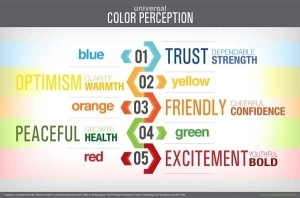
Color Is Nuanced
The neat thing about color is the spectrum is so large. You can always find a color that reflects your brand.
You can blend colors to build upon their strengths. For example, if you add yellow to green you can create a shade that signals more energetic growth. Where as if you add blue to green you create a shade of green that signals a brand that’s more established and trusting.
The choices are endless when discovering the color that reflects your brand.
 My desk is covered in yellow and orange pantone color chips. I am working on refreshing (and simplifying) the Sticky Branding visual identity. It’s been a mishmash of colors and bees for the past six years.
My desk is covered in yellow and orange pantone color chips. I am working on refreshing (and simplifying) the Sticky Branding visual identity. It’s been a mishmash of colors and bees for the past six years.
I have been trying to find the right yellow to reflect my brand, and the choices are endless. I have landed on Pantone 14-0852, also called Freesia. It’s an energetic yellow, but with a richness that I like.
(Stay tuned for more news on the Sticky Branding brand update in the coming weeks. We’re waiting for all the new print collateral from Primo Print to arrive.)
Own Your Color
Color can easily be overlooked and delegated to your graphic designers. But that’s a mistake. Your brand’s color is strategic. It’s the first thing your customers see, and that shapes the tone and expectations for your brand.
Choose your color deliberately and own it. What color is your brand known for?
June 2, 2015
Give Your Customers a Reason to Come Back
A disproportionate amount of sales and marketing’s attention is focused on customer acquisition. But what about your current customers? Why should they come back?
Customer retention is a branding challenge. What separates your business from the competition? And do your customers care enough to come back again and again?
You don’t have to be brilliant at everything. Pick a focal point. What is your business known for?
Focus On Customer Service
Zappos and Nordstrom are known for their customer service. They may not be the cheapest retailers, but they go way above the call of duty to serve their customers.
Delivering exceptional customer service is more than a corporate value, it’s a process. Companies that deliver exceptional customer service invest in it. They hire more people, provide them better training and tools, and give them the freedom and room to delight their customers.
It’s not easy to deliver outstanding customer service, and that’s what makes it a powerful differentiator.
Focus On Choice
Being able to buy everything you’re looking for in one place is appealing. This is what separates Walmart and Amazon from the herd. They can deliver an exceptional number of options in one, convenient place.
Offering breadth of service is a differentiator, provided your customers take advantage of your broad capabilities. This is a differentiator that I suggest cautiously, because offering too many options may dilute your brand. Build your portfolio of products and services around your customer and their needs.
Focus On Your People
David Cronin, CTO of DevFacto, argues, “Happy employees create happy customers.”
In some industries it’s very hard, if not impossible, to differentiate the products or services. Industries that become highly commoditized may not have a lot of external options to differentiate the brand. But that’s not the end of the world because you can differentiate internally.
Organizations that build dynamic cultures stand out. Customers notice happy, engaged, and productive employees.
Your culture creates an energy that radiates out into your marketplace, and sets your brand apart from everyone else.
Focus On The Experience
What’s it like to work with your company? Do you deliver a unique customer experience that sets your firm apart?
Panera Bread designs its stores to be an ideal place for people to meet. Its locations are very different from the hustle and bustle of Starbucks’ stores. You can always find a comfortable place to sit and talk. This creates a unique alternative to many other coffee shops and restaurants.
The experience goes beyond the products and services. It focuses on how your customers interact with the brand, and how you can aid them.
Focus On Convenience
Can you create a hassle free experience?
This could be achieved by where you’re located, and getting really close to your customers. It could focus on the buying experience, and streamlining the process. It could focus on the product, and making it easier to use and maintain.
Saving your customers time and energy is an excellent way to differentiate your brand.
Pick a Focal Point
A brand can’t be all things to all people, and it’s unlikely you can be excellent at all five focal points. Just pick one.
A brand can stand out by doing one or two things better than everyone else.
But always keep your customer in mind:
Do they value the focal point?
Does it bring them back again and again?
The goal is to create an experience that your customers recognize, value, and seek out. What do you have to do to give your customers a reason to come back?
May 28, 2015
The Culture Trap: When Your Organization Derails the Brand Strategy
Developing and implementing new strategies would be so much easier if people didn’t get in the way. But alas, we can’t escape the people problem.
Nothing derails a brand strategy faster than a cultural misalignment. If your team doesn’t buy into the strategy or is unwilling to change its behaviors to achieve the strategy, the strategy will fail.
This is the “Culture Trap.” It’s the human resources issues that slow down or prevent a brand strategy from being implemented effectively.
The Culture Trap is caused by well known HR issues:
The wrong people on the team, which is often a “few bad apples” versus everyone.
Misaligned compensation plans, especially at the middle management level.
A fear or inability to change at the field level — the rank-and-file employees. The bureaucracy becomes cancerous.
Competing corporate priorities. This is a little like trying to serve two masters, and not knowing who to follow.
Mistrust between the organization and the executive team. As the old adage goes, “Once burnt, twice shy.”
These are the issues that keep me up at night when working with a client to reposition their brand and implement a new strategy. I don’t have a silver bullet to overcome the Culture Trap, but here are a few tactics I lead with.
Start With Why
Explain to your team the strategy and why it’s important for the organization:
Where we’re heading, and how we’ll get there.
Why now.
What we know, what we don’t know, and how we’re managing these variables.
What needs to be accomplished, and by when.
The more context you can share with your team the better. Fear, uncertainty, and doubt are triggered by a lack of knowledge.
Share the plan with your team and why it’s critical for the organization’s future. What’s the why behind your brand strategy?
Over Communicate
Implementing a new strategy requires deliberate communication. How will you get the word out on what’s happening on a regular basis?
Build a communication plan that includes a launch, weekly huddles, and quarterly or monthly updates. Then reinforce your verbal communications through print and digital versions. Look for every opportunity to share the story.
You really can’t over communicate when you’re going through a transition.
Ask For Participation
You can tell your employees what to do, but that’s not very motivating. Instead, ask them to come along for the ride.
As you communicate the strategy ask each member of your team for their participation. Ask them for their support.
Change happens so much faster when your team volunteers.
Bite Size Chunks
In larger organizations it may be beneficial to break up the strategy into bite sized chunks. Where can you achieve early wins? Where can you achieve buy in? Where can you shift the culture?
You may focus the strategy implementation on key regions, products, or departments. You don’t have endless resources, so consider how you can roll out the strategy both internally and externally.
Prepare For Turnover
This isn’t pretty or nice, but not everyone on the team may be a fit for the new strategy.
The faster you can replace the people who don’t fit the new strategy, the faster you can overcome the Culture Trap.
Many times the Culture Trap is magnified because the leadership cannot make the hard decisions to terminate or move members off the team.
If a person cannot keep up they’ve got to go.
This can be very hard, but if your organization is not prepared to put the right people on the bus, it’s probably not prepared to be successful either.
Listen
An effective strategy is malleable. You don’t know everything when you develop the strategy — listen, learn, and adapt.
Implement feedback loops into the strategy implementation process. You not only want to monitor how the brand strategy is being received in the market place, you want to monitor how it’s being received internally.
If you’re listening you can catch and resolve issues before they become problems.
Celebrate The Wins
Finally, have fun.
Transitioning your organization and your brand puts a lot of pressure on your team. This can be a very stressful period.
At every opportunity — no matter how small — celebrate the wins. Acknowledge them. Amplify them. Make them important.
Your team is trying. Let them know you truly appreciate their efforts.
May 26, 2015
Who Do You Serve?
One of the most important decisions a marketer can make is to define the target market. Who do you serve?
Defining the audience for your brand gives you a foundation to build upon. It gives you the stability to make decisions:
How to tell your story
How to position your products and services against the competition
How to engage your audience in authentic and meaningful ways
Clearly stating who you serve takes your brand to the next level.
Pick Your Customers
“Attempting to be all things to all customers tends to result in underserving everyone. Even the strongest company or brand will be positioned to serve some customers better than others,” writes Roger Martin and A.G. Lafley in Playing To Win: How Strategy Really Works.
Successful brands — Sticky Brands — are deliberate on who they serve. Harry Rosen, for example, is Canada’s largest premium menswear retailer with 40% market share. But they don’t serve all men equally.
Speaking at the Family Business Forum, Larry Rosen, CEO of Harry Rosen, said, “We call our customers MOPEs — Managers, Owners, Professionals, Entrepreneurs.” The average age of their clients is 38, and the target market is high income males between 20 to 50.
This focus creates a foundation for the Harry Rosen brand. Their products and reputation may engage men outside of the target market, but the brand experience is designed for their audience — from the clothing they sell to where they advertise and promote the brand to the store layout and design.
Who does your company serve?
Which customers value your services the most?
Where does your company deliver a better experience or results?
What market segment(s) should you focus on to grow your brand?
Marketing Comes After Positioning
Which comes first, marketing or the target market? This isn’t a philosophical thought experiment about the chicken and the egg. The target market comes first.
Before you get into any marketing tactics and campaigns take a step back. Deliberately define your target market. Who are you serving?
One of the very first challenges I had to overcome in writing Sticky Branding (the book) was to define the target market. “Who was the book for?”
It was surprisingly difficult to answer, because many of the concepts of the book apply to a broad range of businesses. They are universal truths of branding and marketing in 2015 and beyond.
But to grow a brand requires sacrifice. You have to choose your audience deliberately.
I started by crafting a positioning statement. It took me a few weeks and a lot of iterations but I landed on, “Sticky Branding is a branding playbook for small- and medium-sized companies — companies with a marketing budget, but not a vast one.”
This is the positioning statement I used to pitch the book to publishers, and I held onto it through the entire process — research, writing, and marketing the book. I continue to use it as my elevator pitch for the book.
Being deliberate about who the book was for made it a lot easier to build a brand for the product. I knew where to focus my strategy, because I chose the audience before anything else.
Who Does Your Brand Serve?
Pick your audience. Your brand cannot be all things to all people. It’s a matter of resources. Even Apple with its vast cash reserves cannot be all things to all customers. It has to choose.
Defining who you serve is the foundation of your brand. Ask yourself the three core questions of Simple Clarity:
Your are …
You do …
You serve …
Your brand becomes immediately more distinctive and engaging when it’s focused on a well defined target market.


